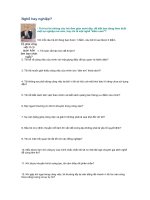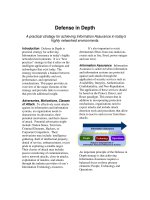Tài liệu E-GOVERNMENT IMPLEMENTATION STRATEGIES docx
Bạn đang xem bản rút gọn của tài liệu. Xem và tải ngay bản đầy đủ của tài liệu tại đây (247.98 KB, 26 trang )
E-GOVERNMENT
IMPLEMENTATION
STRATEGIES
Salvator NIYIBIZI
DIRECTOR E-GOV
RITA
CONTENT
•
INTRODUCTION
•
SITUATION ANALYSIS
•
CRITICAL SUCCESS FACTORS AND
CAUSE OF FAILURE
•
LOGICAL FRAMEWORK AND E-GOV
PROJECTS
•
CONCLUSION
1.INTRODUCTION(Con’d)
Broadly defined, Electronic Government (e-Government) is the use of ICT:
- to promote more efficient and effective government’s activities,
- to facilitate accessibility to government services,
- to allow greater public access to information, and
- to make government more accountable to citizens.
e-Government involves delivering services via the Internet, telephone,
electronic media, community centers (self-service
or facilitated by others), wireless devices or other communications systems
1.INTRODUCTION(Con’d)
e-Government as a driver of growth and
development can help in the realization of
the PRSP within Vision 2020 .
Particularly, e-Government will inter alia:
–
improve services and convenience to citizens;
–
improve the productivity (and efficiency) of government agencies;
–
create a more accountable government;
–
increase transparency and fight corruption;
2.SITUATION ANALYSIS
2.1 Strength
2.2 Weaknesses
2.3 Opportunities
2.4 Threats
2.1. Strengths
-There is a political will in support of ICT
-The national ICT Policy:NICI II
-There are some legislative and regulatory framework
-There is supportive tax on ICT equipments
-Mobile tele-density and internet usage is improving at impressive/high rate
-ICT in schools,universities and other institutions is improving
2.2. Weaknesses
•
Difficulties in attracting, recruiting and retaining skilled ICT personnel
•
Inadequate budgetary allocations and poor prioritization.
•
Erratic and unstable power supply. Most of rural communities do not have
electricity.
•
Most of the offices are not networked and interconnected through
LAN/WAN
•
Insufficient number of ICT equipments including computers. Some
Ministries do not have PABXs
2.2. Weaknesses(con’d)
•
Most used computers are mainly utilized. They are mainly used as
word processors
•
Limited usage of Internet and email facilities, with only few
computers connected.
•
ICT implementation in key functional areas such as health,
banking, procurement, education, commerce, etc are still minimal
or lacking.
•
Connectivity is concentrated in the capital city and a few major
towns
•
Limited and expensive bandwidth.
2.2. Weaknesses(con’d)
•
There is duplication of efforts in some ICT projects
•
Illiteracy and language barriers for most rural communities.
•
Lack of local content that is readily available and relevant to the needs of
the majority of Rwandans
•
Lack of awareness about ICT and the benefits of e-government in both
urban and rural areas
•
Lack of supportive legal framework such as for the protection of
intellectual property rights, database protection, informational privacy and
electronic transactions.
2.2. Weaknesses(end)
•
The mainly static web sites available in government
ministries are seldom updated.
•
There are inadequate standards and guidelines for ICT in
general including training, career development,
information security and devices.









